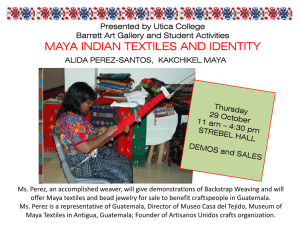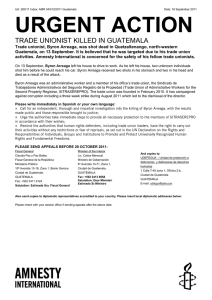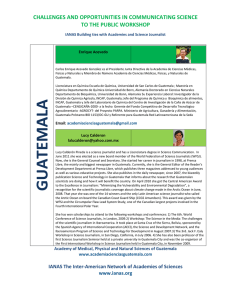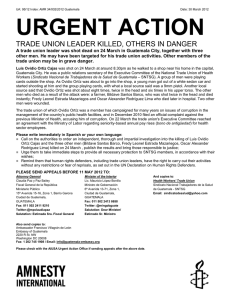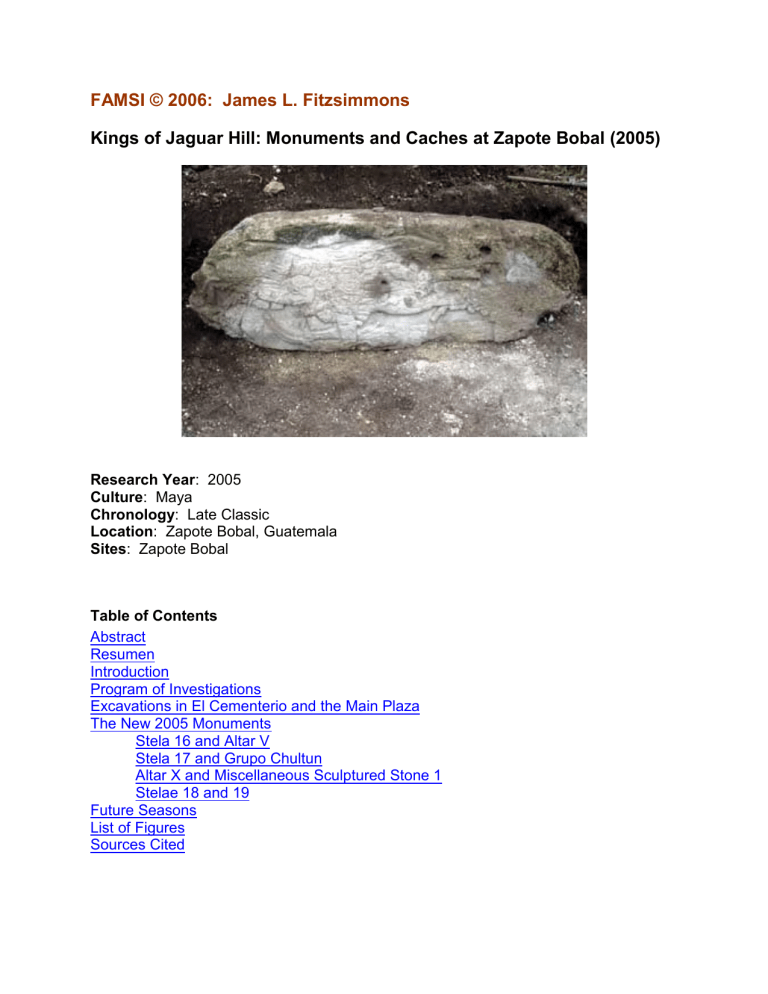
FAMSI © 2006: James L. Fitzsimmons Kings of Jaguar Hill: Monuments and Caches at Zapote Bobal (2005) Research Year: 2005 Culture: Maya Chronology: Late Classic Location: Zapote Bobal, Guatemala Sites: Zapote Bobal Table of Contents Abstract Resumen Introduction Program of Investigations Excavations in El Cementerio and the Main Plaza The New 2005 Monuments Stela 16 and Altar V Stela 17 and Grupo Chultun Altar X and Miscellaneous Sculptured Stone 1 Stelae 18 and 19 Future Seasons List of Figures Sources Cited Abstract This FAMSI grant, received by the Proyecto Petén Noroccidente for the 2005 field season, supported the first excavations at the Classic Maya site of Zapote Bobal, Guatemala. The fieldwork phase of this project began in June 2005 with the consent of IDAEH and continued into July, after which time several months were spent analyzing the results of excavation in the project laboratories in La Libertad and Antigua, Guatemala, as well as at university locations in the United States and France. FAMSI funds were specifically used during the field season to excavate and document the sculptural record at the site; during the course of season, as outlined in the following paper, several caches as well as new monuments were uncovered. Together with data from other parts of the site, these monuments and caches have provided the first glimpse of ritual life at a polity known to us from the Classic Maya inscriptions as Hix Witz, or "Jaguar Hill". Resumen Esta concesión de FAMSI, recibida por el Proyecto Petén Noroccidental para la temporada de campo del 2005, apoyó las primeras excavaciones en el sitio Maya Clásico de Zapote Bobal, Guatemala. La fase de trabajo de campo de este proyecto empezó en junio del 2005 con el consentimiento del IDAEH y continuó en julio, después se emplearon varios meses analizando los resultados de la excavación en los laboratorios del proyecto en La Libertad y Antigua, Guatemala, así como en las universidades en los Estados Unidos y Francia. Los fondos de FAMSI se usaron específicamente durante la temporada de campo para excavar y documentar el registro de esculturas en el sitio; durante el curso de la temporada, como se perfiló en el este informe, se descubrieron varios escondites rituales como también nuevos monumentos. Junto con la información de otras partes de la ciudad, estos monumentos y escondites nos han proporcionado la primera pista de la vida ritual de un gobierno conocido por nosotros en las inscripciones Clásicas Mayas como Hix Witz, o "Cerro Jaguar". Submitted 08/18/2006 by: James L. Fitzsimmons [email protected] Introduction For over twenty years the name Hix Witz, or "Jaguar Hill", has been recognized in Maya texts of the Classic Period (250-850 AD; Mathews 1985). Women from this kingdom appear as royal brides at ancient Maya centers alongside male captives; Hix Witz elites can be found on hieroglyphic monuments bringing tribute to the lords of sites like Piedras 2 Negras or Yaxchilan. The recent identification of Hix Witz as the Late Classic site of Zapote Bobal, Guatemala (Stuart 2003; Figure 1), prompted the Proyecto Petén Noroccidente – previously based at the site of La Joyanca – to initiate a long-term program of investigations at Zapote Bobal in 2004. The project is focused on how this newfound polity formed and survived within a web of larger, historically robust kingdoms who described capturing, killing, and even marrying the Hix Witz nobility. Figure 1. Zapote Bobal and related sites. Directed by James L. Fitzsimmons (Middlebury College), Laura Gamez (Universidad de San Carlos, Guatemala), and Veronique Breuil (CEMCA, Guatemala), the project is a long-term international effort by US, Guatemalan, and French investigators to understand ancient Maya state formation and development at Zapote Bobal. In their inscriptions, outsiders from the Usumacinta, Central Petén, and Petexbatun regions habitually portray this site as a martial proving ground, a valuable (if militarily coerced) ally, and – in the case of Dos Pilas – a refuge for exiled rulers (Federico Fahsen, personal communication 2004). Research at the site between 2004 and 2005 has demonstrated that the Zapote Bobal dynasts saw themselves in a decidedly different light, creating numerous 3 hieroglyphic monuments, a royal palace, and several temple-pyramids to edify their own social, political, and even military prowess (Fitzsimmons 2004, 2005). Despite the fact that the scale of construction within Zapote Bobal befits a long-lived ancient Maya center, it is clear that the site flourished for approximately 200 years and collapsed by 800 AD. Research on the periphery of the site, by comparison, has demonstrated a considerably older and longer history of occupation; the contrast between the core and the periphery of the site indicates the imposition of a relatively new center upon an older sociopolitical landscape. The visible elements of this imposition are represented by profligate – albeit dispersed – monumental architecture within the site core as well as over 40 hieroglyphic altars and stelae (Figure 2). These Late Classic (600850 AD) elements do not, however, adequately address (1) why the area covered by the site core was not previously occupied; (2) the relationship between the original inhabitants of the area and the later Zapote Bobal dynasts; (3) how the rulers of Zapote Bobal manufactured a past for themselves and manifested that past on the physical landscape; and (4) how that manufactured past compares with the evidence from the site periphery. That we can begin to address these issues in future seasons reflects upon the results of the 2005 season, in which a preliminary chronology as well as firm evidence for a "manufactured past" were obtained by way of the generous support of FAMSI. Figure 2. The site core of Zapote Bobal, Guatemala. 4 Program of Investigations Excavations at Zapote Bobal in 2005 concentrated in two major areas of the site: the Main Plaza and an area to its east dubbed "El Cementerio", corresponding to the locations of all known monuments at Zapote Bobal previously registered in 2004. These 2005 excavations were complemented by several other avenues of inquiry, including 1) the complete mapping of the site core and the continuation of mapping/survey endeavors on the site periphery; 2) the continuing registration (e.g., mapping, cleaning, and consolidation) of looter’s tunnels in the Main Plaza as well as Structure 65, the largest pyramid at the site; 3) the documentation of all known monuments and monument fragments; and 4) the analysis and documentation of all excavated materials, particularly with regard to the establishment of a ceramic chronology within the civic-ceremonial center of Zapote Bobal. The FAMSI facet of this research, limited to the excavations around and identification of new monuments at Zapote Bobal, was complemented by project research in the above areas. For example, the 2003-2005 mapping efforts at the site, under the direction of Edy Barrios (USAC, Guatemala), resulted in the registration of over 400 structures within a 1-2 km radius around the site; Stelae 18 and 19 were, in fact, identified within one of the numerous mound groups along the southeastern periphery of Zapote Bobal. Continuing efforts in the looter’s tunnels in Structures 1-3 and 65 yielded evidence of a relatively abrupt occupation phase for the site: these buildings seem to have been erected to their final heights after only three to four phases of construction. Maps and profiles of these and other looter’s trenches at the site continue to be produced, providing a record of the devastation wrought by looters at the site as well as inadvertently demonstrating construction history for many of the major buildings within the site core and beyond. These pits were augmented by archaeological excavations that were primarily oriented around clarifying our knowledge of existing architectural features as well as gaining ceramic and other samples for laboratory analysis. The Late Classic looted tomb (T1) found beneath Structure 2 was a special case (Figure 3), requiring cleaning, further excavations, and consolidation: despite its looted state, it was clear upon excavations that the tomb had never been properly occupied with human remains. Instead, it had been plastered, vaulted and stocked with grave goods. Several telling materials were missed by the looters during their foray into the tomb, including jade and shell artifacts as well as a partially intact hieroglyphic bone ring identifying an individual bearing a title whose first part was ochk’in ’west’. If followed by kaloomte’, of course, this would be an allusion to the great (but defunct, in the Late Classic) Mexican metropolis of Teotihuacan (Martin and Grube 2000: 17); despite thorough and multiple screening, however, the second part of the title was never recovered. 5 Figure 3. Structure 2, showing looter’s trenches as well as Tomb 1 (T1). Excavations in El Cementerio and the Main Plaza Although radiocarbon dates for the first excavations at Zapote Bobal are currently outstanding, laboratory analysis of all of the ceramics recovered at the site – including those represented within the excavations described below – indicate that the core of Zapote Bobal was solely occupied during the Late Classic and that the periphery dates to a considerably earlier time period, perhaps as far back as the late Preclassic. As a result, it is no surprise that the test pits excavated within the FAMSI facet of research at Zapote Bobal are considerably shallower than initially expected: throughout the site core, bedrock is approximately 1-2 meters below the ground surface. During the course of the 2005 season, ten test pits (numbered S1-S10) were excavated within El Cementerio (Figure 4). These pits, oriented around Stelae 1-6 and 14-16, were designed to gain ceramic and other samples as well as define local stratigraphy; explore the dimensions of and imagery on stelae partially visible from the surface; find the base of each stela so as to establish their original orientations and stratigraphic relationships to one another; and establish whether stela caches, common to other Classic Maya sites, were in evidence at Zapote Bobal. 6 Figure 4. The monuments of El Cementerio, prior to excavation. In addition to the discovery of more stelae and altars in this area, a welcome situation that presented itself when the area was partly cleared of low-lying vegetation, research in El Cementerio resulted in several preliminary conclusions about one of the most enigmatic ceremonial spaces at the site. First, between the new monuments and excavations, it seems clear that the Hix Witz dynasts laid out at least four lines of monuments bordered by a shallow terrace in front of Structure 55; all of the construction in El Cementerio appears to have been punctuated by the laying of only two floors in relatively quick succession. Both floors, on the basis of ceramics, date to the Late Classic Period, and demonstrate types similar to those recovered at nearby La Joyanca as well as several others diagnostic of the Central Petén; no Early or Preclassic sherds were recovered from anywhere in El Cementario. The limited quantities of other artifact types from these floors, based upon preliminary analysis, are consistent with the hypothesis that the Grupo Ritual Central was non-residential in character. Second, it now seems clear that at least two monuments in El Cementerio were moved, in Classic Maya times, to their current locations from somewhere else. Altar C and Stela 1, dated from inscriptions to 642 and 663 AD, respectively, appear to have been set in their current positions sometime during the 8th century AD. In fact, of the monuments attached to test pits during the 2005 season, only one is clearly native to the original, 7th century floor: Stela 14. Because the cultural stratigraphy of El Cementerio is so shallow, 7 at times only 50 cm in total, with only two floors separated by 15-20 centimeters, it seems likely that the entire program of activities in this area was limited to only a few Hix Witz dynasts. To date, there are only a handful of royal persons mentioned in texts at the site: Taj Chan Ahk (Stela 15), Wa’ Ahk (Stela 1), Tak Chapat (Tomb 1, Stela 6?), and Chan Ahk (Stela 12). Perhaps one or more of these was involved in an ambitious attempt to create a long and glorious history for the site where, admittedly, a few hundred years before there had been almost nothing at this spot. Figure 5. Cache of stones beneath Stela 14. Third, another feature limited to the 7th century floor was a cache found in front of the base of Stela 14 (Figure 5); no caches were associated with Stela 1, 3, 4, or 6. The cache consisted of seven river cobbles in a tightly arrayed bundle. Given the role of bundles in Maya religion past and present, it seems likely that the cache represents part of a tuun-binding ritual where, at a select Period Ending, the Classic Maya would wrap with cord a series of stones (tuun) symbolic of the time elapsed. In this case, it would seem that the cache, and with it Stela 14, were dedicated on a 7-tuun date; unfortunately, the stela itself provides no information as to when in time that tuun fell. A second special feature, Special Deposit 1, was recovered near the base of Stela 5 but associated with the terrace; one of the cut stones of the terrace, to the right of Stela 5 and on axis with Structure 55, had been placed atop two overturned vessels. As this behavior has not been observed elsewhere at Zapote Bobal, it is difficult to interpret its meaning; although the vessels do not bear signs of "kill-holes" or similar signs of a termination/dedication 8 ritual, it seems possible that the vessels were set for this purpose. Further excavations along the terrace may reveal similar such deposits. Finally, excavations at the base of each stela demonstrated that as the monuments of El Cementerio were erected (or moved to their present location), different methods of holding each of them in place were used. Thus for Stela 2, a formal "box", or cajon, and supporting platform was created to keep it erect; as this was perhaps the best built of the "boxes", consisting of rectangular cut stones held together with mortar, it is no wonder that Stela 2 is still standing in its original location (Figure 6). All of the other stelae at the site have either broken away from their "box" or been uprooted entirely through natural or human actions. Other "boxes" or other forms of support were encountered at the bases of Stelae 1, 14, 5, and (in the Main Plaza, see below) 8. Stratigraphically, all of these features – save those associated with Stela 14 – appear to be intrusive to the earliest floor for El Cementario and contemporary with the final phase of occupation. Figure 6. Stela 2 and its "box". In terms of their construction, the support for Stelae 5 is similar to that of Stela 8 in the Main Plaza (see below). Both consist of a few uncut stones mixed with a thick (.5-1 m) layer of mortar and abut other architectural features: Stela 5 is set against the stones of a low-lying terrace contemporary to the final phase floor, while the cajon of Stela 8 is braced by the base of Structure 2. In all respects the cajon for Stela 1 appears to have 9 been a sloppy affair, with uncut boulders, rubble, and mortar thrown loosely together in a rough outline for the monument. Stela 14, by comparison, has no supporting stones or "box" whatsoever; its base was held firmly in place by a dense mortar, such that when its top eventually broke off, the cajon and part of the base remained fast. In addition to S1-S10, two more test pits were sunk in the Main Plaza, the first in front of Stela 8 (S11) and the second in front of Stela 9 (S12). Stela 8, which was partially buried by fill from the looting of Structure 2, was found to have been paired with an altar at its front (Altar X, see below) and inset into the plaza with a "box" and mortar (see above). The test pit in front of Stela 9 revealed not only that the stela was not in situ, as placed on the site map, but also that the cultural sequence of the Main Plaza too was quite shallow (ca. 50-70 cm) and comprised of only two floors above bedrock. The New 2005 Monuments During the 2005 seasons, four stelae (Stelae 16-19), three altars (Altars V-X), one miscellaneous sculptured stone (MSS 1), and two altar supports (tentatively assigned to Altar U, discovered during the 2004 season) were encountered at Zapote Bobal (see catalogue of Other Images). The stelae and altars, in keeping with the standard established during the 2003 season, were numbered and lettered, respectively. Although none of the altars bore clear evidence of additional carving or writing, they were noteworthy for continuing the general pattern of altar shapes at Zapote Bobal. Apparently, there are three distinct types of altars found at the site: (1) shallow, flat discs which can be carved on one face (e.g., Altars V or Q) and supported by oblong stone blocks; (2) short, squat altars bearing no evidence of further work or altar supports (e.g., Altar W or Altar M); and (3) oval altars, occasionally bearing rows of text (e.g., Altars X or C). As is unfortunately the case with several monuments at Zapote Bobal, the new stelae and altars were heavily pitted, burned, and/or fragmentary as a result of prior agricultural and looting activities. All were measured, photographed, and registered with IDAEH and, as necessary, are in the process of being drawn. Within the park, moreover, all monuments bearing traces of hieroglyphic or iconographic material were buried for the purposes of preservation; several will be unearthed for further analysis or excavations in future seasons. Stela 16 and Altar V Stela 16 (348×104×31 cm) was recovered from "El Cementerio" in line with several other monuments, apparently part of a large monumental program within a plaza fronting Structure 55 and bordered by Structure 53. This area appears to have been designed with display in mind: there are at least five lines of monuments in the plaza, oftentimes in paired stela-altar formation as is typical of monumental programs in the Central Petén. The placement of Stela 16 as well as Altar V breaks this general pattern, as both were 10 encountered in the "third" line fronting Structure 55. A test-pit overlapping a portion of Stela 16 resulted in the discovery of an eroded figure on its posterior side, but due to its burned, fragile condition no further actions were taken. Altar V was badly burned but displayed no clear evidence that it had ever borne images or text. Stela 17 and Grupo Chultun The remains of Stela 17 are testament to the extensive looting endemic to the Petén. Its two fragments (60×67×29 cm; 73×54×44 cm), one bearing the remains of a feathered headdress (Stela 17a), were also fire-damaged and paired with the broken Altar W. Despite the deplorable situation, the discovery of this paired stela and altar was coupled with the recognition that they were in line with Stelae 12 and 13. During the clearing of this thickly vegetated area, moreover, chultunes ("sinkholes") emerged in rough association with each one of the stelae. Although these were not investigated during the 2005 season due to time constraints, it is imperative that excavations take place in 2006 to fully understand the relationship between these three features. The stelae, altars, and sinkholes of this Grupo Chultun would have been prominent features in the landscape of Zapote Bobal. They are atop a raised, apparently natural outcropping modified by lowlying platforms, and would have been visible from both "El Cementerio" and the massive Structure 65. Given that sinkholes and other cavernous features were, in the Classic Maya mindset, not only useful as sources of water but also entrances to the Underworld, it is likely that Grupo Chultun was a locus of habitual ceremonial activity for the Hix Witz dynasts. Figure 7. The "dancing" Chan Ahk of Stela 12. 11 The "dancing" (ak’otaj) Chan Ahk on Stela 12 supports this idea. The exact name of his dance or its associations – from the text – are unknown, but we can nevertheless get a sense of what Stela 12 was designed to convey. We may see Chan Ahk merely dancing on the bottom register of the monument (leg movement notwithstanding), but if we take into account the physical location of the stela and its relationship to a sinkhole, we suddenly find Chan Ahk dancing near an Underworld "entrance". This idea, combining art with natural features, is reminiscent of Underworld dances performed by the Classic Maya Maize God (or imitators) on ceramics and monuments in various parts of the Lowlands, most notably at Palenque. When we think about Stela 12 – and, by extension, Stelae 13 and 17 – in this way, we see into the mindset of the individuals who commissioned this group. Knowing whether these same individuals left material evidence of their activities in Grupo Chultun can only refine our ideas about the Hix Witz nobility in this area. Altar X and Miscellaneous Sculptured Stone 1 Both of these monuments were encountered within the site core. The former, split into two pieces (90×65×46 cm; 60×52×42 cm), was recovered immediately to the west (in front) of Stela 8, a large hieroglyphic monument associated with Structure 2. The latter was recovered in a small – apparently residential – group due east of the royal Acropolis. Miscellaneous Sculptured Stone 1 is particularly noteworthy, as it was clearly unfinished; from its overall shape and the cuts visible on its surface, it appears as if this stone was designed to be a large, flat altar. Excavations in this area will be necessary to determine when this undertaking was initiated. Stelae 18 and 19 These monuments were identified on private land and registered on the final day of the 2005 season; both were encountered approximately 2 km southeast of the site core. Stela 18 had been buried for its protection by local landowners, such that only a small portion was visible from the surface; as excavations were not allowed at the time, it was thereby largely unavailable for suitable photography or measurements. Stela 19 was located approximately 50 meters from its buried fellow and had unfortunately been exposed not only to the elements but also repeated fires before its nature was determined. It nevertheless displays a figure engaged in the "scattering" of incense, a behavior that likely indicates a Period Ending being observed by the Hix Witz dynasts; the line of glyphs near the figure’s ankles is similar to the pattern found on Stela 12. Unfortunately, all that can definitively be said about Stela 19 is that stylistically it dates to the Late Classic, probably some time between the late 7th and 8th century AD. 12 Future Seasons The 2005 excavations undertaken in El Cementerio and the Main Plaza have revealed a clear attempt by the Classic dynasts at Zapote Bobal to create a monumental program befitting a much longer-lived Maya center. Rows of paired and unpaired altars and stelae were raised within a short length of time, some of them moved from other locations to the Grupo Ritual Central (GRC). This monumental program extended beyond the site core at least as far as the modern town of Vistahermosa, Guatemala, approximately 4-5 km away from the Acropolis, where small heavily looted temple-pyramids as well as platforms have been encountered. One urgent task for future seasons will involve registering and protecting these outlying buildings as well as monuments from further damage: while looting has largely (but not completely) stopped in this area, structural instability and erosion continue to take their toll on monuments and architecture in portions of the site outside of the formal archaeological concession. Given that occupation at the site core of Zapote Bobal seems to have been rather shortlived, one of the major unanswered questions at the site involves the area’s prior inhabitants: how did the descendants of Preclassic and Early Classic local populations, in evidence within the rural sector of Zapote Bobal, figure in the growth and collapse of this Late Classic polity? Surveys have already revealed hundreds of structures surrounding the Late Classic Acropolis in a 1-2 km radius, with settlement density extending outwards for 2-3 km more. The establishment of a palace and several temple-pyramids within a previously occupied landscape calls to mind dynastic splits or other social upheavals at Late Classic sites elsewhere in the Maya lowlands, particularly those based in the Petexbatun; this sudden growth would have drastically affected local geopolitics and created a need for the rapid expression and reinforcement of newly emergent political power. Monuments were likely but one of the ways in which this power was expressed, and future seasons at the site proper will focus on how and why this situation came to be. Perhaps one answer lies in the relationship between the Late Classic center of Zapote Bobal and a center to the northwest that has recently revealed at least one example of the Hix Witz place name in its inscriptions (Stuart 2003), the site of El Pajaral. List of Figures Figure 1. Zapote Bobal and related sites. Figure 2. The site core of Zapote Bobal, Guatemala. Figure 3. Structure 2, showing looter’s trenches as well as Tomb 1 (T1). Figure 4. The monuments of El Cementerio, prior to excavation. Figure 5. Cache of stones beneath Stela 14. 13 Figure 6. Stela 2 and its "box". Figure 7. The "dancing" Chan Ahk of Stela 12. Other Images Monuments Test Pit S1 Test Pit S2 Test Pit S3 Test Pit S4 Test Pit S5 Test Pit S6 Test Pit S7 Test Pit S8 Test Pit S10 Test Pit S11 Test Pit S12 Test Pit S13 Test Pit S14 Test Pit S15 Test Pit S16 Test Pit S17 Test Pit S18 14 Test Pit S19 Test Pit S20 Other Images 15 Sources Cited ARNAULD, Charlotte and Paulino MORALES Informe No. 1, Primera temporada de campo Proyecto Petén Noroccidente 1999 La Joyanca. Informe prepared for the Instituto de Antropología e Historia, CEMCA, Guatemala. ARNAULD, Charlotte, Erick PONCIANO and Véronique BREUIL Informe No. 2, segunda temporada de campo Proyecto Petén Noroccidente 2000 La Joyanca. Informe prepared for the Instituto de Antropología e Historia, CEMCA, Guatemala. BREUIL, Véronique, James L. FITZSIMMONS, and Laura GAMEZ 2004 Zapote Bobal, ciudad de Hixwitz. Paper presented at the XVII Simposio de Investigaciones Arqueológicas en Guatemala, Museo Nacional de Etnología y Arqueología, Guatemala. BREUIL, Véronique and Mélanie FORNE Notas preliminares sobre la cerámica del sitio La Joyanca y su región. In XIV 2001 Simposio de Investigaciones arqueológicas en Guatemala, J.P. Laporte, A.C. Suasnavar y B. Arroyo, pp. 807-824, Ministerio de Cultura y Deportes, Instituto de Antropología e Historia, Asociación Tikal, Guatemala. BREUIL, Véronique, and Laura GAMEZ Informe No. 6, sexta temporada de campo Proyecto Petén Noroccidente. 2005 Informe prepared for the Instituto de Antropología e Historia, CEMCA, Guatemala. BREUIL, Véronique, Laura GAMEZ, James L. FITZSIMMONS, Jean-Paul METAILIE, Edy BARRIOS, and Edwin ROMAN 2004 Primeras noticias de Zapote Bobal, una ciudad maya clasica del norocidente de Peten, Guatemala. Mayab 17: 61-83. BREUIL, Véronique, Erick PONCIANO and Charlotte ARNAULD Informe No. 3, tercera temporada de campo Proyecto Petén Noroccidente - La 2001 Joyanca. Informe prepared for the Instituto de Antropología e Historia, CEMCA, Guatemala. 16 BREUIL, Véronique, Tristan SAINT-DIZIER and Salvador LOPEZ Informe No. 4, tercera temporada de campo Proyecto Petén Noroccidente - La 2002 Joyanca. Informe prepared for the Instituto de Antropología e Historia, CEMCA, Guatemala. BREUIL, Véronique, Salvador LOPEZ, Tristan SAINT-DIZIER and Laura GÁMEZ Informe No. 5, tercera temporada de campo Proyecto Petén Noroccidente - La 2003 Joyanca. Informe prepared for the Instituto de Antropología e Historia, CEMCA, Guatemala. FITZSIMMONS, James L. 2004 The Classic Maya Kingdom of Hixwitz Rediscovered: Excavations at Zapote Bobal, Guatemala. Invited paper presented at the University of Cambridge, UK. 2005 Excavations at a Classic Maya capital in the northwest Petén, Guatemala. Paper presented at the University of South Dakota. FITZSIMMONS, James L., Laura GAMEZ, and Véronique BREUIL n.d. Zapote Bobal y la historia de Hix Witz. Invited paper under preparation for the Journal de la Societé des Americanistes. FORNE, Mélanie La secuencia cerámica de La Joyanca, Petén Noroccidente. In XV! Simposio 2003 de Investigaciones Arqueologicas en Guatemala, H. Escobedo y J.P. Laporte (éds.), Museo Nacional de Etnología y Arqueología, Asociación Tikal, Guatemala. GAMEZ, Laura, and James L. FITZSIMMONS Informe No. 7, septima temporada de campo Proyecto Petén Noroccidente 2005 Informe prepared for the Instituto de Antropología e Historia, CEMCA, Guatemala. GRAHAM, Ian The ruins of La Flórida Petén in Peabody Museum Papers Vol. 61, pp. 4291970 455, Harvard University, Cambridge. GRAHAM I, and Eric VON EUW Corpus of Maya Hieroglyphic Inscriptions, Vol.3. part 3. Yaxchilan, Peabody 1982 Museum of Archaeology and Ethnology, Harvard University, Cambridge. 17 HOUSTON, Stephen D., Héctor ESCOBEDO, Richard TERRY, David WEBSTER, George VENI, and Kitty F. EMERY 2000 Among the river kings: archaeological research at Piedras Negras, Guatemala, 1999. Mexicon 22(1): 8-17. KAUFMAN F., and M.A. LEAL Proyecto Arqueológico Peruano Guatemalteco al Noroccidente de Petén, 1988 Publicacíon de la Universidad de San Carlos de Guatemala, Guatemala. LEAL, Marco Antonio and Salvador LOPEZ 1993 Reconocimiento arqueológico en la brecha topográfica Libertad-Xan (sector Tamariz-Río San Pedro). Basic Resources Int. Guatemala. MATHEWS, Peter 1985 The sculpture of Yaxchilan. Unpublished Ph.D. dissertation, Yale University. MOCK, Shirley Preface. In Mock (ed.), The Sowing and the Dawning: Termination, Dedication, 1998 and Transformation in the Archaeological and Ethnographic Record of Mesoamerica. University of New Mexico Press, Albuquerque. STUART, David 2003 La identificacion de Hixwitz. Paper presented at the XV Simposio de Investigaciones Arqueologicas en Guatemala. Museo Nacional de Arqueologia y Etnologia de Guatemala. 18

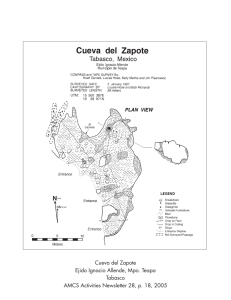
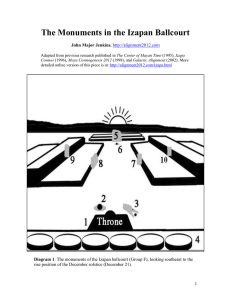
![FERROVIAS Guatemala [illegible] Guatemala City, September 16](http://s2.studylib.es/store/data/006239407_1-e2fc4da168ab6d0785009124ea28e0c9-300x300.png)
